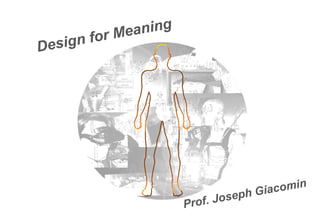Design for menaing
- 1. Design for Meaning Prof. Joseph Giacomin
- 3. Meaning âĒthe significance, purpose or underlying truth of something (the what); âĒthe motive or intention of something (the why).
- 4. Function âĒthe way something works or operates; âĒthe natural purpose of something or the duty of a person. Some things need doing, with or without aesthetic or semiotic content.
- 5. Function
- 6. Ritual âĒa series of actions or a type of behaviour which is regularly and invariably followed by someone; âĒa set of fixed actions and sometimes words performed consistently and regularly, especially as part of a ceremony or collectively. Some actions are performed for their aesthetic and semiotic content. The motions and actions send messages.
- 7. Ritual Many products and services appear to be designed based on a ritual...
- 8. Myth âĒa traditional story, especially one concerning the early history of a people or explaining a natural or social phenomenon; âĒan idealised, exaggerated or fictitious conception of a thing or person. Some things are pure aesthetic or semiotic content. Motions or actions may not be necessary.
- 9. Myth Many products and services appear to be designed based on a myth...
- 10. Bosch, P. 1985, Context Dependence and Metaphor, in W. Paprotte and R. Dirven (eds) The Ubiquity of Metaphor, John Benjamins Publishing, Amsterdam, Netherlands, pp141-176. Meaning Changes With Context âthe triangleâ âthe small oneâ âthe large oneâ âthe equilateral oneâ âthe white oneâ Natural Description For the Leftmost ObjectâĶ
- 11. - Meaning Sometimes Changes With Gender - Meaning Sometimes Changes With Age - Meaning Sometimes Changes With Culture And Various Studies Have shown thatâĶ
- 12. Meaning Changes With Time (Myth â Ritual â Function) Pantzar, M. 1997, Domestication of Everyday Life Technology: dynamic views on the social histories of artefacts, Design Issues, Vol. 13, No. 3 (Autumn), pp. 52-65. There seems to be a metamorphoses of novelties from âtoysâ to âinstrumentsâ, from âluxuriesâ to ânecessitiesâ, from âpleasureâ to âcomfortâ, or from âsensationâ to âroutineâ. When commodities are integrated with each other, e.g., within lifestyles, dwellings, neighbourhoods, etc., there is less and less room for spontaneity. From the perspective of a single consumer, daily choices, of say, using cars, become increasingly dictated by situational factors, routines, and social norms, and less and less by individual preferences.
- 13. Meaning Changes With Time (Function â Ritual â Myth) Pullin, G. 2009, Design Meets Disability, MIT Press. Spectacles have become eyewearâĶ you wear glasses rather than carry or just use them. This acknowledges the shift in perspective from a medical model to a social model of prescription. In the past, spectacles were seen almost exclusively in terms of their vision correction. This broader perspective acknowledges the significance of the perceptions of those around you.
- 14. An Example: the 20-20-3 study
- 15. 20 ArtefactsâĶ
- 16. 20 PeopleâĶ 10 users 10 designers
- 17. 3 QuestionsâĶ âIs the meaning of the artefact mostly functional, ritual or myth?â âWhat adjectives best describe the artefact?â âWhat product features best communicate the identified meaning?â
- 18. Users vs DesignersâĶ Function Ritual Myth users (n=10) 128 112 101 designers (n=10) 117 76 81 all (n=20) 245 188 182
- 22. Thank you.
- 23. Ideology Pre-existing Meaning New Meaning MythRitual Pre-existing Metaphor New Metaphor Product/Service Characteristics Designing For Meaning Framework Meaningfication* * The use of data, design ethnography, real fictions and co-creation for the purpose of designing artefacts based on new meanings which emerge from the interconnection of evolving patterns of technology, experience, personal identity, societal identity, value assignation and consumption. Function























